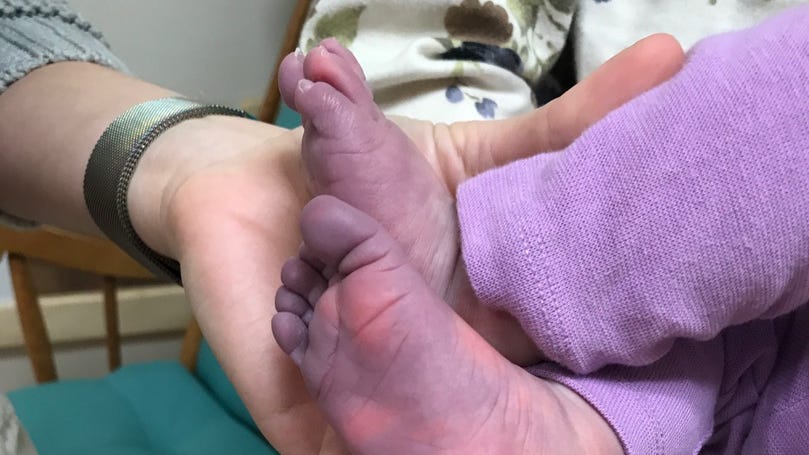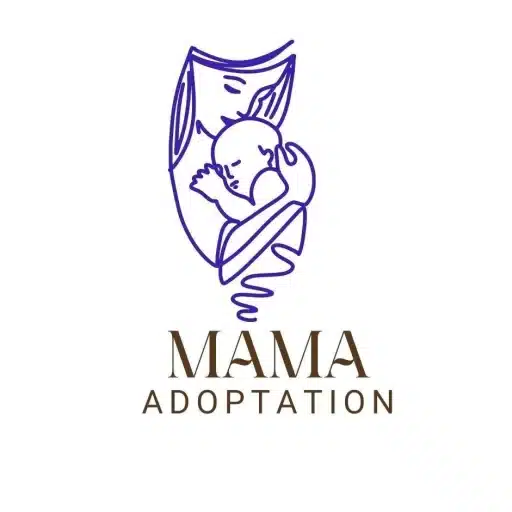It is normal for newborn baby’s leg and feet turning purple including hands especially in the first few weeks of life. This is due to a condition called acrocyanosis, which occurs when the blood vessels in the extremities constrict due to cold temperatures or low oxygen levels. When this happens, the blood cannot adequately flow through these areas, and they turn purple.
- Why do baby legs, and feet turn purple?
- How long do newborn hands and feet stay purple?
- Is it normal for newborn baby's leg and feet turning purple?
- Baby’s Legs And Feet Turning Purple in the First Days, Weeks, and Months:
- What if purple hands, legs, and feet turn blue?
- What if the baby’s legs turn purple when crying?
- What if the baby’s legs turn purple in the carrier?
- What if there is a purple spot on the baby’s foot or leg?
- Specific health factors that cause acrocyanosis in babies
- Conclusion:
- FAQ’s
Acrocyanosis is usually harmless and resolves itself on its own as babies grow older and their circulation improves. However, there are a few things to keep in mind:
- If the purple discoloration is accompanied by other symptoms, such as difficulty breathing, lethargy, or poor feeding, it could be a sign of a more serious medical condition and you should seek medical attention immediately.
- If the purple discoloration is only on one limb or is accompanied by swelling or pain, it could also be a sign of a problem and you should see a doctor.
- If you are concerned about acrocyanosis, talk to your baby’s pediatrician. They can help you determine if it is normal or if there is something else going on.
Why do baby legs, and feet turn purple?
It can be worrying for parents to see their baby’s leg and feet turning purple. As an expert pediatrician, I will discuss the common causes behind babies hands, legs and feet turning into purple:
The medical term for this is acrocyanosis, which occurs when the blood vessels in the extremities of a baby constrict due to cold temperatures or low oxygen levels in the air around them. When this happens, the blood cannot adequately flow through these areas, and they turn purple instead.
Parents often notice this happening more frequently during the summer when babies are dressed too warmly or not wrapped tightly enough. It also tends to occur at night, as babies may become chilled while sleeping in an unheated room.
Fortunately, there isn’t much cause for concern with acrocyanosis, and it usually resolves itself on its own as babies grow older and their circulation improves.
How long do newborn hands and feet stay purple?
Newborns often experience a striking change in appearance when their legs and feet start turning purple. It is usual for legs and feet to turn purple in babies up to two weeks old, yet the duration of this phenomenon remains unclear.
Known as cyanosis, this discoloration of newborn limbs is attributed to the baby’s circulation system adapting to life outside the womb. While some babies may have their leg and foot discoloration disappear within a few hours or days post-birth, others may find that it takes several weeks before their skin color returns to its original hue.
Parents need to keep an eye on their baby’s skin color if they notice any changes in complexion due to the potential risk of developing jaundice or other medical conditions that could be serious if left untreated.
Is it normal for newborn baby’s leg and feet turning purple?
Newborn babies often have unexpected physical changes, leading many parents to worry that their baby is experiencing something abnormal. One concern frequently arises when a newborn’s hands, legs, or feet turn purple.
While this can be concerning for parents, it’s essential to know that these discolorations are usually typical and nothing to worry about. This change in skin color is generally the result of increased blood flow caused by the warmer room temperatures and tight clothing or swaddles babies wear.
This extra blood causes the capillaries in their hands and feet to expand, showing a purplish hue on their skin. In most cases, this discoloration should disappear within a few minutes after removing any tight clothing or blankets and cooling the room temperature.
Baby’s Legs And Feet Turning Purple in the First Days, Weeks, and Months:
According to the National Library of Medicine, medications provide mild improvement, while lifestyle changes are the main form of treatment for managing purple legs and feet (acrocyanosis).
1. First Day:
During the first day after birth, it’s not uncommon for a newborn’s legs and feet to exhibit a bluish or purple tint. This can be attributed to the physiological adjustment of the circulatory system as the baby transitions from the womb to the external environment.
2. First Week:
In the initial week of life, acrocyanosis, the temporary bluish discoloration of extremities, may still be noticeable. This phenomenon is often a result of the newborn’s circulatory system continuing to adapt to the extrauterine environment. Most cases of acrocyanosis during this period are benign and self-resolving.
3. Two Weeks:
Around the second week, a baby’s legs and feet may still exhibit a bluish or purple tint. This can be attributed to a normal developmental process called acrocyanosis. During acrocyanosis, the baby’s circulatory system is still adjusting to the outside environment, and the temporary discoloration is a result of the blood circulation adapting to the new conditions.
4. Three Weeks:
In the third week, it’s common for acrocyanosis to persist to some extent. The baby’s circulatory system continues to mature, and the small blood vessels in the extremities may still be adjusting. While the intensity of the discoloration may vary, gradual improvement is typically observed during this period.
5. First Month and Beyond:
As the weeks progress into the 5 month, the intensity of acrocyanosis typically diminishes. The baby’s circulatory system matures, and the body becomes more adept at regulating blood flow. It’s common for the bluish or purple hue to gradually fade, and by the end of the first month, many infants exhibit normal skin coloration.
- 4 months: Purple discoloration in a 4-month-old’s feet may be normal (acrocyanosis), but persistent concerns require evaluation by a pediatrician.
- 8 months:Your 8-month-old’s purple feet are likely due to acrocyanosis, a common and benign condition related to temporary circulatory adjustments. Consult your pediatrician for reassurance and guidance if needed.
What if purple hands, legs, and feet turn blue?
What if purple hands, legs, and feet turn blue? It’s a strange phenomenon reported by some individuals in recent years. While it’s not a common occurrence, it can still be a scary experience when you’re the one experiencing it.
If you find yourself in this situation, there are several possible causes for why your skin might have changed colors. It could be due to an allergic reaction or a medical condition like Raynaud’s disease. Medications like steroids or antibiotics can also temporarily cause your skin to change color.
The most important thing to do is visit your doctor immediately so they can properly diagnose the cause of the color change and provide appropriate treatment options. This will help ensure that you get back on track toward health and wellness with minimal disruption to your life!
Baby’s hands and feet turn purple after the bath:
When it comes to children, parents often worry about the most common and uncommon health issues that may arise. One of these more uncommon problems is when a child’s hands and feet turn purple after a bath. This condition can worry any parent, as they may not know what is causing the color change or if this could indicate an underlying medical issue.
This condition occurs due to sudden exposure to cold water, which causes the blood vessels to constrict, leading to decreased circulation in the extremities, such as the hands and feet.
This sudden exposure can cause a bluish or purplish discoloration on legs, arms, or other body parts, which should resolve after some time when warm blood flow returns. In some cases, however, it may take longer for normal skin coloration to return, and if this persists, then medical attention should be sought immediately.
What if the baby’s legs turn purple when crying?
A baby’s cries are expected to be accompanied by loud wails, red cheeks, and tear-soaked eyes. But what if the baby’s legs or feet were turning purple? While many parents may find this alarming, it is essential to know that it could be completely benign.
Legs and feet turning purple when crying can occur in healthy babies and those with underlying medical conditions. This phenomenon is known as ‘acrocyanosis,’ which occurs when there is a decrease in blood circulation to the extremities due to cold temperatures or stress. It usually presents as a blue-purple discoloration of the arms and legs, although some babies may also experience this on their face or chest.
What if the baby’s legs turn purple in the carrier?
Suppose you’ve noticed your baby’s legs and feet hanging purple while on the page; you may wonder what’s happening. It could be something as simple as a harmless circulation issue or something more serious. Whatever the cause, it is essential to take action and understand why this is happening so that you can ensure your baby stays safe and healthy.
There are a few potential reasons your infant’s legs and feet are turning purple in the carrier. One of the most common causes is simply poor circulation due to a tight fit. Tightly wrapping your baby too snugly can restrict blood flow and cause their extremities to turn purple or blue. Additionally, if there is a decrease in body temperature, babies may experience poor circulation, leading to discoloration of their limbs.
Baby’s legs turn purple when held:
It’s an alarming sight: their legs and feet suddenly turn purple when a baby is held. Parents may wonder what’s causing this discoloration and if it’s cause for medical concern. Baby’s legs turning purple can have several causes, but most commonly occurs due to the baby pooling blood in the lower extremities. This happens when a baby’s circulation gets blocked off, which can occur due to many things, such as a tight diaper or too much time spent on their back with their legs extended.
It is most common after eating or crying, where pressure on the abdomen pushes blood down into the feet and hands. Fortunately, it is usually harmless, although some medical conditions like Raynaud’s syndrome or acrocyanosis could also be responsible for this symptom.
What if there is a purple spot on the baby’s foot or leg?
If your baby has a purple area on their foot or leg, it can concern parents. Leg and feet turning purple is a symptom of many medical conditions ranging from minor issues to serious health problems. Parents need to know what causes their baby’s legs and feet to turn purple so they can seek proper treatment.
The most common cause of purple spots on the legs or feet is bruising. Babies are particularly prone to bruising because they are more active than ever, often leading them into contact with objects that result in bruises and scrapes.
If the bruise is not severe, it should fade over time without any medical treatment necessary; however, if it begins to look worse or does not heal properly, you should speak with your pediatrician about further treatment options.
Specific health factors that cause acrocyanosis in babies
Acrocyanosis in infants results from a combination of factors related to their early physiological development. The immature circulatory system of newborns, still adapting to the transition from the womb to the external environment, can contribute to temporary discoloration of the extremities. Limited oxygenation in the initial days or weeks of life, as well as peripheral vasoconstriction in response to factors like cold or stress, may also play a role. Additionally, hormonal influences during birth and the postnatal period can impact the baby’s circulatory system. While acrocyanosis is generally considered a normal and harmless condition, parents should consult a healthcare professional if concerns arise or if the bluish discoloration persists, ensuring a thorough evaluation and appropriate guidance for the baby’s well-being.
Conclusion:
Parents must know the signs and symptoms of a circulation problem in babies, such as baby’s legs and feet turning purple. It’s important to monitor their baby’s feet and contact a pediatrician if any discoloration is noticed. Taking precautions, like keeping the baby’s feet elevated and ensuring socks fit correctly, can also help.
FAQ’s
Q1: When does acrocyanosis typically occur in newborns?
Acrocyanosis often appears within the first few days of life and tends to resolve on its own as your baby’s circulatory system matures.
Q2: Is acrocyanosis a cause for concern?
Generally not. Acrocyanosis is a normal response to the adjustment of your baby’s circulatory system and usually poses no health risks.
Q3: How can I differentiate between acrocyanosis and a more serious condition?
Acrocyanosis is distinguished by its symmetrical appearance and resolves with warming. Consult your pediatrician if you have concerns or notice other symptoms.
Q4: Can I do anything to alleviate acrocyanosis in my baby?
Keeping your baby warm, especially in cooler environments, can help. However, always consult your pediatrician for personalized advice.
Q5: When should I seek medical attention for purple discoloration?
If discoloration persists, spreads unevenly, or is accompanied by other concerning symptoms, consult your pediatrician promptly for a thorough evaluation.
Read more: Why Do Newborn Eyes Get Crusty? (What’s Normal & What’s Not)








